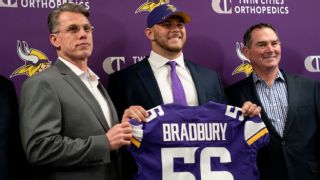|
The Minnesota Vikings walked away from the NFL draft with the least amount of controversy possible surrounding their record 12 picks. From addressing the offensive line twice in the first four rounds, including with their first-round pick, to finding a potential No. 3 pass-catching threat and a running back who can split the load with Dalvin Cook, it’s hard to argue that the Vikings didn’t do exactly what they needed to with their rookie class. Going all-in on offense, especially with their first four selections, while walking away with a haul of seven offensive players emphasized the team’s top priority: upgrading the pieces around quarterback Kirk Cousins so he can be successful in 2019. General manager Rick Spielman expects his first three picks to fill immediate needs. According to Spielman, there was no way Minnesota was going to trade out of its top two picks, at Nos. 18 and 50, given where the team had Garrett Bradbury and Irv Smith Jr. on its board and how highly valued they were as potential Day 1 players. Bradbury, whose flexibility helps upgrade two positions on the interior of the offensive line, is expected to start at center or guard as a rookie. Smith gives the Vikings' offense an element it has been missing with an athletic F tight end. Running back Alexander Mattison is expected to fill Latavius Murray’s shoes as a big-bodied back who can complement Cook with a sizable workload. If things play out perfectly, the Vikings can improve their dormant rushing attack and become more explosive in the passing game. But despite how well this draft panned out, at least in the early rounds, Minnesota is relying on a handful of rookies to play big roles in protecting and elevating Cousins in the most pivotal season of his career. Things played out this way because the Vikings made defense the priority in free agency. After the team directed its available spending to linebacker Anthony Barr and defensive end Everson Griffen, it had just enough remaining to find an offensive starter from the bargain bin in the second wave of free agency. Minnesota believes it has its starting right guard in Josh Kline, whom the team signed to a three-year deal worth $15.75 million with $7.25 million in guarantees. The Vikings had to use the draft to address their remaining offensive needs, given how little spending money they have.  Spielman’s legacy will be affected by how the O-line performs. The great deal of high draft capital used on Bradbury and to trade up in the fourth round to land Oklahoma guard Dru Samia reflects how much this franchise thought it needed to fix its weakest link. Spielman’s legacy will be affected by how the O-line performs. The great deal of high draft capital used on Bradbury and to trade up in the fourth round to land Oklahoma guard Dru Samia reflects how much this franchise thought it needed to fix its weakest link.
Although it’s difficult to imagine one or two rookies and a lower-tier veteran immediately remedying a line that gave up a league-high 227 pressures, the fact that the unit's issues were tackled head-on this offseason shows a franchise trying to do to better. “We need to run the ball. We need to be better on offense, and that's where we needed the help,” Spielman said. “Offense was kind of a point of emphasis, and we were never going to pass up a defensive guy if he's sticking that high on our board, and one of those guys would have fallen. We were never going to not take the best player. But as we went down through the draft, I thought it fell very well for us on the players that we did get on the offensive side.” The Vikings might be taking a gamble on the expected impact of their high draftees, but this offseason has been spent pulling from Cousins' past to support the QB in Year 2. Minnesota believes Gary Kubiak’s offensive philosophy and scheme will be similar to what Cousins had with the Shanahan/McVay systems in Washington. Second-round pick Smith also reminds Spielman of another player who experienced a great deal of success with Cousins in the past. “That type of tight end we haven’t had here, and I know that’s a big part of Gary Kubiak’s offense and Kevin Stefanski’s offense right now,” Spielman said. “The other thing I thought was, don’t want to put [Smith] there yet, but he has a lot of [Jordan] Reed-like traits in Washington, and that’s why he was very appealing to us.” Reed caught a career-high 87 passes for 952 yards and 11 touchdowns during Cousins’ best season as a pro in 2015. The Vikings might view Smith as the perfect comparison for one of the QB’s favorite weapons while expecting the Alabama product to become the No. 3 receiving threat behind Adam Thielen and Stefon Diggs. That could be the main reason the Vikings chose to wait until the seventh round to draft two receivers and address the need for a running back at the end of the third. Finding a player who is as effective in the slot as he is lined up outside gives Cousins the luxury of a versatile pass-catcher who could grab the No. 3 receiver role that has gone unclaimed the past few seasons. Although this group of offensive rookies boasts promise, none of it will matter if Cousins struggles. Minnesota ranked 19th in points per game (22.5) and was 20th in total offense (345.6) en route to missing the playoffs last season. There is as much pressure on Cousins to perform as there is on his supporting cast. The type of players the Vikings brought in last week might not change the QB Cousins is, but their ability to elevate his game could play an important role in how much this offense improves in 2019.
|
